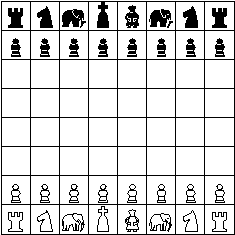THE MAT-AL-MAGNUN THE "FOOLS MATE" IN SHATRANJ
by DR. RENÉ GRALLA, HAMBURG/GERMANY
Surprise attacks by "Queens" and long-range Bishops - that have been invented as part of the transformation of slow-motion Arabic Shatranj into the modern version of chess at the end of the 15th century - do lead to premature knock-outs in all too many matches of FIDE Chess. Two examples of basic few-movers in modern FIDE Chess do illustrate that.
Show-case No. 1: The Fool's Mate in nowadays chess - with a little help ... by the FIDE Chess-Queen ...
White: GM Comins MansfieldBlack: Trinks
1961, USA Open Chess Championship
Fred Defence
1.e4 f5 2.Nc3 g5?? 3.Qh5# 1:0
The fastest ever recorded checkmate in a tournament of Western Chess. And now a 5-mover.
Show-case no. 2: Fooling around in nowadays chess - with a little help by the FIDE Chess-Bishop ...
White: Mile DragicevicBlack: Dr.René Gralla
5-Minutes-Blitz; December 8th, 2005;Serbian Cultural Centre, Hamburg/Germany (source: http://www.chessbase.de/nachrichten.asp?newsid=5217)
From's Gambit (ECO AO2)
1.f4 e5 2.fxe5 d6 3.exd6 Bxd6 4.Nf3 g5 5.h3?? Bg3# 0:1
The Classic Arab Chess does neither know the piece of omnipotent "Queen" nor the long-range "Bishop". Instead of modern Bishops, on the board of Shatranj there are "Elephants" (abbreviation: "E"; Arabic: "Alfil") and "Vezirs" (abbr.: "V"; Arabic: "Firzan"), instead of nowadays "Queens". The diagram below demonstrates the starting-out position in Arabic Shatranj.

Coordinates of White Army:
King d1; Vezir e1; Rooks a1 / h1; Knights b1 / g1; Elephants c1 / f1; Pawns a2, b2, c2, d2, e2, f2, g2, h2.Coordinates of Black Army:
King d8; Vezir e8; Rooks a8 / h8; Knights b8 / g8; Elephants c8 / f8; Pawns a7, b7, c7, d7, e7, f7, g7, h7.
The main difference between modern FIDE Chess and ancient Shatranj: The
predecessor of the modern "Queen", the "Vezir" (abbr.: "V"), can only
walk one step diagonally per move. The predecessor of the modern
"Bishop", the "Elephant" (abbr.: "E"), leaps to the second diagonal
square on the given diagonal where that unit is positioned; the first
diagonally adjacent square on the diagonal of the Elephant is out of
reach for that unit.
Apart from the foregoing, the King, the Rooks and the Knights move the
same way as their successors do in nowadays FIDE Chess (please note,
however, that unlike to modern international chess there is no castling
option in Shatranj). The Pawns march the same way as the Pawns of FIDE
Chess do. With two more modifications: There is no initial two-step Pawn
move - consequence: there is no "en passant"-capture option - , and
those Pawns that manage to reach the opponent's last rank can be
promoted to Vezirs only.
Taking into consideration the foregoing, one could reasonably assume
that - since there are neither mobile "Queens" nor "Bishops" in Classic
Arabic Chess -, those notorious "Checkmates of the Fools" by surprise
attacks in the early stages of matches of Shatranj are virtually
impossible, namely because of the fact that there are not available the
necessary units to execute strikes like that.
But chess is always the source of many surprises : that kind of surprise
that is very funny for the spectators, but that is distinctively less
funny for those who are taken by surprise.
Show-Case no. 3: Mansuba 2007 "Mat-al-Magnun" - "The Fool's Mate" in Classic Arabic Chess
Even in totally relaxed Shatranj the players have to be on the alert.Left-hand Knight Opening
1.Nb1-c3 e7-e6 2.Nc3-a4 ...
A dare-devil squadron scouts the terrain.
2. ... Ng8-e7?
A kind of Old-Indian grouping in the opening, but - big surprise! - losing a Pawn already.
3.Na4-c5! ...
Three moves in a row: an amazing swing by that left-wing White Knight. That is the winner.
White: Rook a1 // Elephant c1 // King d1 // Vezir e1 // Elephant f1 // Knight g1 // Rook h1; Pawn a2 // b2 // c2 // d2 // e2 // f2 // g2 // h2 ; Knight c5;
Black: Pawn e6; Pawn a7 // b7 // c7 // d7 // Knight e7 // Pawn f7 // g7 // h7; Rook a8 // Knight b8 // Elephant c8 // Vezir d8 // King e8 // Elephant f8 // Rook h8
Now Black is forced to give up his defenceless Pawn b7. Do not forget: The right-wing Black Elephant c8 is spying on a6, by eventually leaping there whereas Black Pawn b7 is out of reach for Black Elephant c8.
And if Black foolishly tries to save that doomed infantry unit ...
3. ... b7-b6??
Black wants to catch the White Squadron on b7 - since, after White Horse has cockily got to b7 once, there will be no way back home for that cavalry unit. The problem is: White Horse does not need to retreat anymore ...
4.Nc5-b7 # 1:0
White: Rook a1 // Elephant c1 // King d1 // Vezir e1 // Elephant f1 //
Knight g1 // Rook h1; Pawn a2 // b2 // c2 // d2 // e2 // f2 // g2 // h2
; Knight b7;
Black: Pawn e6 ; Pawn a7 // b7 // c7 // d7 // Knight e7 // Pawn f7 // g7
// h7; Rook a8 // Knight b8 // Elephant c8 // Vezir d8 // King e8 //
Elephant f8 // Rook h8
Incredible: Even in Arab Chess a kind of very early "Fool's Mate" is possible - the dreaded "Mat-al-Magnun".
Postscript by Hans Bodlaender
Who would have thought that there is also a Fool's Mate in Shatranj, with its slow pieces? I briefly talked with René Gralla on the telephone, and we expected that the old Arabs probably will have known this Fool's Mate. Would they have written this down in some of their ancient texts? Who knows? And how often will an unsuspecting player have lost his game in just a few moves 1001 years ago?Written by René Gralla. Webpage made by Hans Bodlaender.
WWW page created: January 30, 2007.